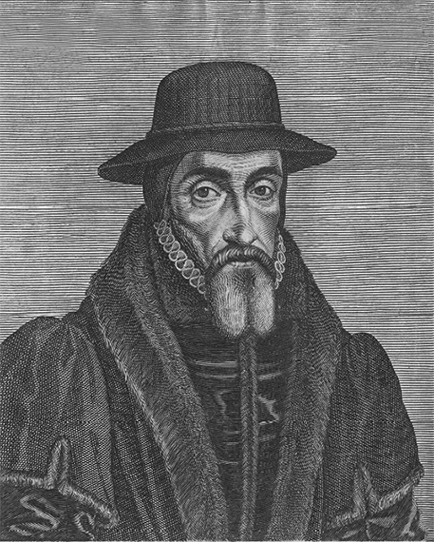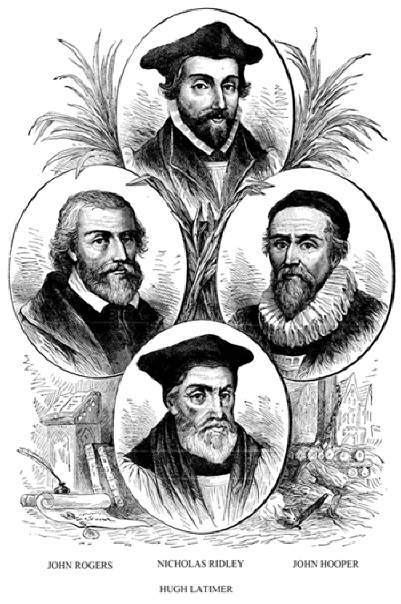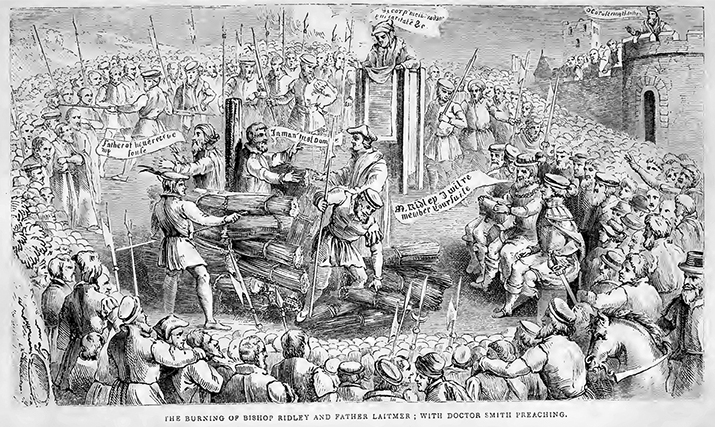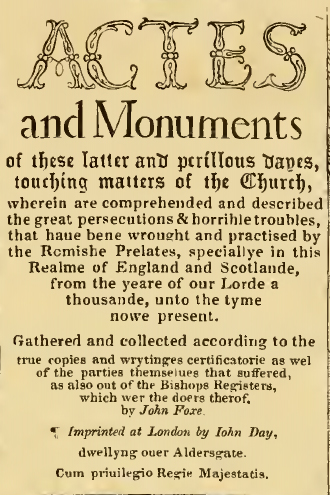John Foxe (1516-1587AD)

Engraved by George Glover, 1641AD, from an oil portrait of 1587AD by unknown artist.
Martyrologist of the Protestant Reformation.
JOHN FOXE was born at Boston, Lincolnshire. At the age of 16 he is said to have entered Brasenose college, Oxford. His authenticated connection at the university is, however, with Magdalen college, of which he became a fellow in 1539, resigning in 1545. It was during this period of abject poverty that he was one day sitting in a church when a complete stranger handed him some money and told him not to worry as in a few days he would receive employment, which happened. He never ever found out who that stranger was.
Soon after leaving Oxford he married Agnes Randall. After holding two tutorships he was driven from England by the accession of Queen “bloody” Mary, and he retired to Strasbourg, where he occupied himself with a Latin history of the Christian persecutions, which he had begun at the suggestion of Lady Jane Grey.
This book, dealing chiefly with Wycliffe and Huss, and coming down to 1500, formed the first outline of the Actes and Monuments. It was printed by Wendelin Richelius with the title of Commentarii rerum in ecclesia gestarum (Strasbourg, 1554). In the same year Foxe moved to Frankfort, where he found the English colony of Protestant refugees divided into two camps, the Calvinists and the Anglicans, and made a vain attempt to frame a compromise, but failed. He moved (1555) to Basle, where he worked as a printer’s reader to Johann Herbst (or Oporinus). He made steady progress with his great book as he received reports from England of the religious persecutions there, and he issued from the press of Oporinus his pamphlet Ad inclytos ac praepotentes Angliae proceres . . . supplicatio (1557),—a plea for toleration addressed to the English nobility. In 1559 he completed the Latin edition of his martyrology and returned to England. He lived for some time at Aldgate, London, in the house of his former pupil, Thomas Howard, now duke of Norfolk. and became associated with John Day the printer, himself once a Protestant exile. Foxe was ordained priest by Edmund Grindal, bishop of London, in 1560, and besides much literary work he occasionally preached at Paul’s Cross and other places. His Martyrology had rendered great service to the Government, and he might have had high preferment in the church but for the Calvinist views which he consistently maintained, and his imperviousness to worldly ambition. He held, however, the prebend of Shipton in Salisbury cathedral, and is said to have been for a short time rector of Cripplegate.
In 1563 was issued from the press of John Day the first English edition of the Actes and Monuments of these latter and perillous Dayes . . . by John Foxe, commonly known as the Book of Martyrs. Its popularity was immense. “Bloody” Mary's persecution was still fresh in the people's minds, and the graphic narratives of noble suffering for the cause of Jesus Christ and His Truth, intensified in its many readers a fierce hatred for the murderous Roman Catholic Inquisition of Philip II and Spain. Nor has its influence ever waned where innocents continue to suffer for their Christian faith. There can be no doubt that for generations the conception of Roman Catholicism was derived from its pages as a dangerous despotism when it has the power to wield the secular sword through its all-too-willing collaborators.
Due to the immediate criticisms by Roman Catholic writers Foxe proceeded to produce a second corrected edition, thoroughly revised from more living witnesses of the times of persecution. It was called the Ecclesiastical History, contayning the Actes and Monuments of things passed in every kynges tyme . . . in 1570, a copy of which was ordered by Convocation to be placed in every collegiate church.
It must also be remembered in his honour that his advocacy of religious toleration was far in advance of his day. He pleaded with Elizabeth I, who respected him, to spare the lives of some despised Dutch Anabaptists, in the belief that in their ignorance they may yet come to be enlightened by the grace of God and come to see the truth. He failed in this.
He died on April 18, 1587 and was buried at St. Giles, Cripplegate.
FOUR ENGLISH MARTYRS

Martyrdom of Latimer & Ridley at Oxford in 1555AD

“But the greatest sacrifice to popish cruelty was yet to come, for on the 16th of October 1555 Bishop Ridley and Bishop Latimer were burned alive, at a single stake, in Oxford. The older Latimer died quickly, but Ridley was a long time in agony, his lower parts being burned before the fire reached his upper body.
Ridley’s last words to his fellow-sufferer were, “Be of good heart, brother, for God will either assuage the fury of the flame or enable us to abide it.” Latimer replied, “Be of good comfort, for we shall this day light such a candle in England as, I trust, by God's grace, shall never be put out.”
The very same day Gardiner, their great persecutor, was struck with the illness of which he died; it was a suppression of urine, which held him in great agonies till the 12th of November, when he expired. He would not sit down to dinner till he had received the news from Oxford of the burning of the two bishops, which was not till four of the clock in the afternoon, and while he was at dinner he was seized with the excruciating pain which eventually put an end to his life.”

from First Edition dated 1563AD
from "Acts and Monuments", volume 5, 1828AD edition
1. John Frith, His examinations and martyrdom 1533AD. (192k) pdf (160k) docx (56k)
2
William Tyndale.
(216k)
Translator of Bible into English, martyred in 1536AD
3. Anne Askew. (220k) Her interrogations, torture and martyrdom, 1546AD. pdf (115k) docx (60k)
Web Pages
1.
WILLIAM TYNDALE
Translator of Bible into English, martyr, 1536AD
3. JOHN HOOPER
English bishop, martyr,1555AD
4